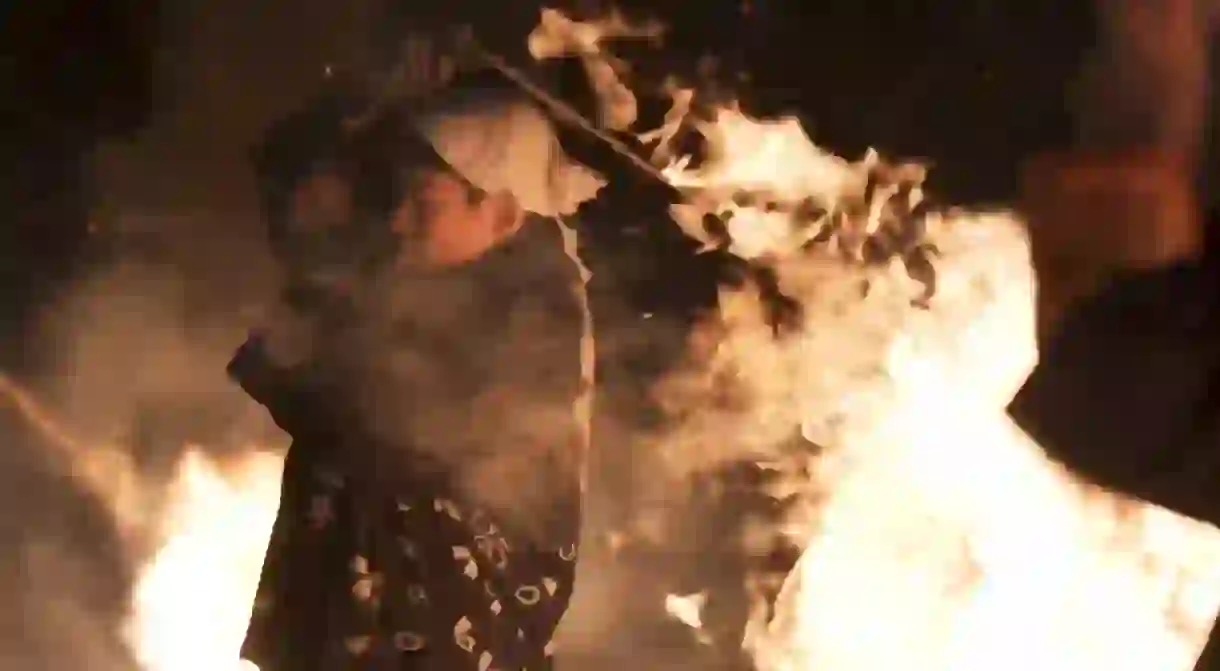Hiburi Kamakura: The Festival of Fire and Snow

Surrounded by a ring of spectators, a hiburi dancer takes hold of his weapon – a fiery bale of hay and charcoal. Their enemy is not one that can be seen or heard. But to the locals of Kakunodate it’s a threat that cannot be ignored.
Zen Buddhists have a saying about enlightenment: “To burn Mount Sumeru with the light of a firefly.” In other words, to try to reach enlightenment through logic or common sense is futile; like trying to light up a mountain with the glow of an insect. But that hasn’t stopped the locals of Kakunodate from trying.
Every lunar new year, around mid-February, a snowy corner of Akita Prefecture hosts the Hiburi Kamakura, the Festival of Fire and Snow. The rituals mark the end of winter and the beginning of spring, but they also invite the positive energy of good spirits, or ‘kami’.
Alongside the frozen Kinokinai River near a cluster of sleeping cherry blossom trees, locals construct little igloos called kamakura – shrines for the Shinto water god, Sui Jin. Children rush from one kamakura to the next, respectfully making offerings in return for good health and fortune. Like all animist gods, Sui Jin is partial to a bribe of mochi balls and sake.
Sui Jin is one of the ‘good’ spirits and is mainly in charge of protecting fishermen. But in the landlocked town of Kakunodate, he is called upon to protect rice fields and to prevent failed harvests. Harvesting rice is a tricky trade and, since many people in this region still make a living through agriculture, nobody is taking their chances. Especially given the threat of Yuki-Onna, or the ‘Snow Woman’.

In some stories, Yuki-Onna is depicted as a complex woman whose bitterness was borne from a life of tragedy. But many believe she was plain evil from the very start. In some parts of Japan, those who don’t acknowledge her shrill cries are punished, and shoved into a valley to their death. Children in Akita are told early on that if they’re not careful, the snow woman will come to eat their souls.
In Japanese animism, all spirits must be appeased, no matter how uncooperative they might be. During the first part of the Hiburi Kamakura festival, a shrine is constructed in their honour, decorated with offerings and good luck charms. Shinto priests, or kannushi, lead the worship. Dressed in thin silk robes, these figures of pink, red and blue punctuate the snow covered landscape. They recite prayers in calm, measured tones, defying the elements with their equanimity. Before them is a group of men with their heads bowed in reverence, stoically standing their ground against the evil spirits of winter.
As the night goes on, a bonfire is lit and bales of hay and charcoal are tied up with lengths of straw rope. Locals participating in the Hiburi dance prepare by wrapping their hair in headscarves and slipping their hands into protective gloves, to stop them from getting singed. The stage for the battle against Yuki Onna is set.

A dancer takes hold of one end of the rope as the attached bale is set on fire. Slowly, the bale picks up momentum and forms a protective halo. A rush of wind feeds oxygen to the flame and the fire roars to life as it swings faster and faster. The heat melts the falling snow into rain. Tendrils of fire curl magnetically around the dancer’s body.
The fire illuminates the faces of the crowd like the backlit frames of a reel of film; expressions suspended in delight, awe and wonder. The hiburi dancers transport the audience to a spiritual realm; a world where ghosts and spirits rule; where logic and common sense fall short; a place where the mystical properties of fire might be the only thing humans can use to defend themselves against misfortune.
The hiburi dancers must withstand intense heat and dense clouds of smoke until they’ve forced out the evil spirits of winter. Eventually, when the flames are flickering just inches away from the hands, the bale is swung into the direction of a bonfire. Is Yuki-Onna gone for good? Only time will tell. Have they done enough to summon Sui Jin? The livelihoods of locals in Kakunodate may depend on it.
It’s no coincidence that there’s a symmetry in the kanji for fire (火) and human (人); the curved legs of these two kanji represent the potential for both good and bad. Fire can bring death and destruction, but can also create warmth, light and energy. Similarly, according to Buddhist conceptions of good and bad, humans at their worst can exist in a purely physical world where all that exists is what can be seen, heard and felt. But, if they choose to fulfil their potential for good, they can live in the spiritual world. And in doing so, they can reach the mythical Mount Sumeru and experience enlightenment.
It might look like the locals of Kakunodate are just swinging balls of flaming hay around their bodies. But if you look a little deeper, you might be lucky enough to see Mount Sumeru, on fire with the light of Hiburi Kamakura.













